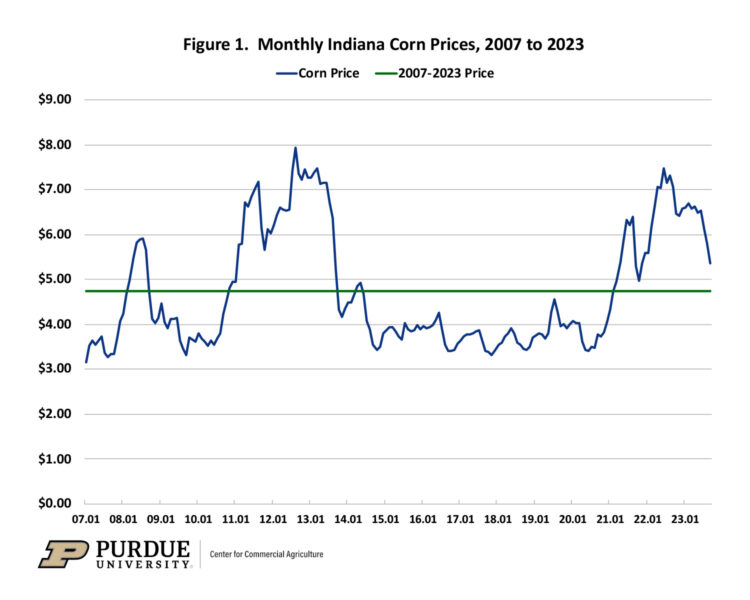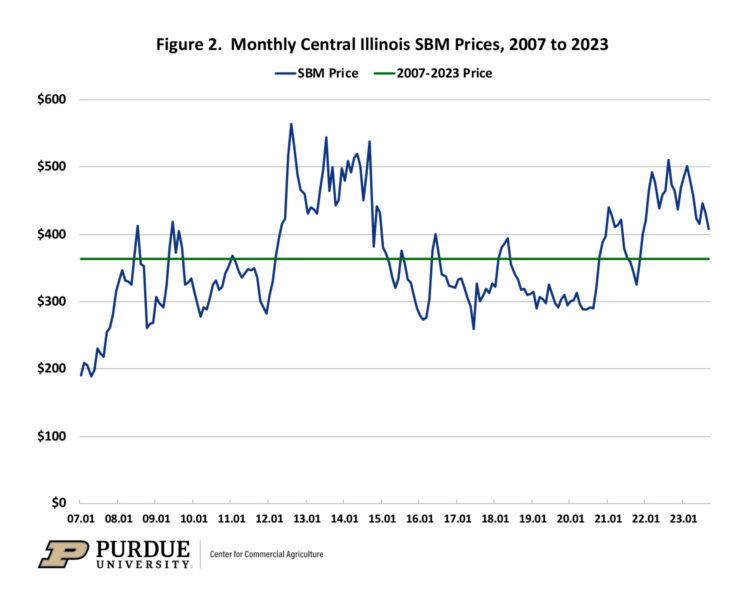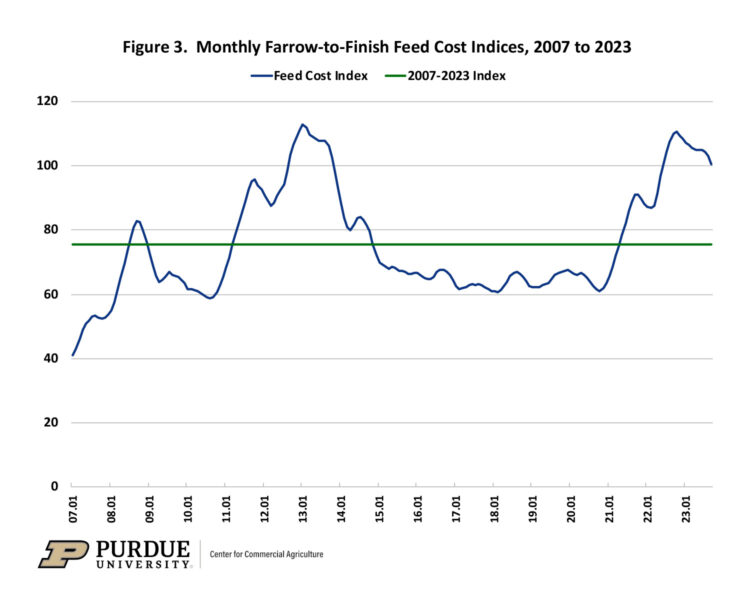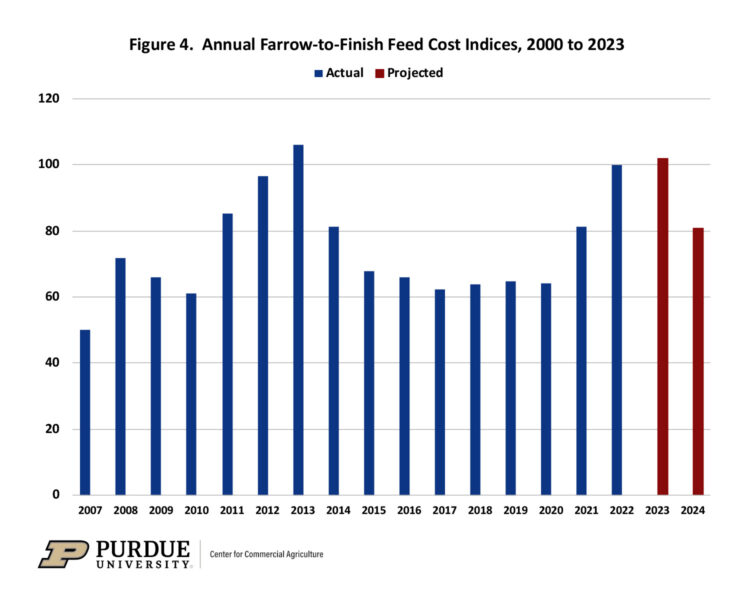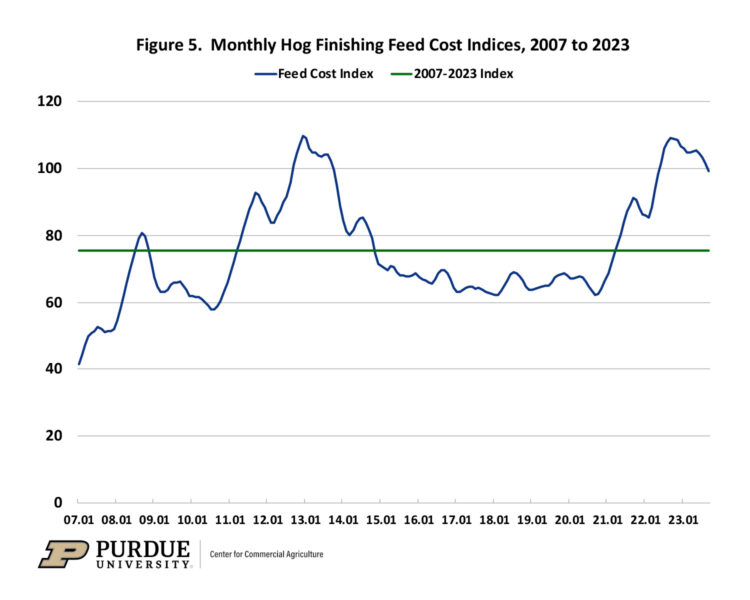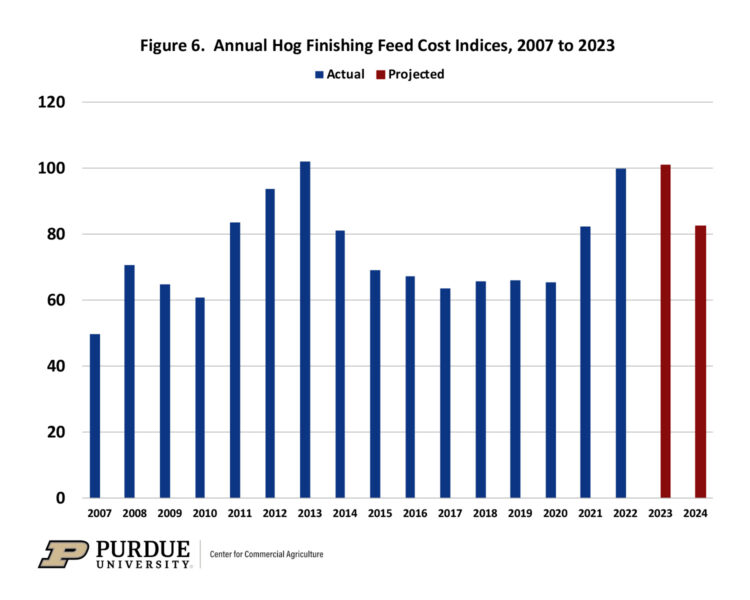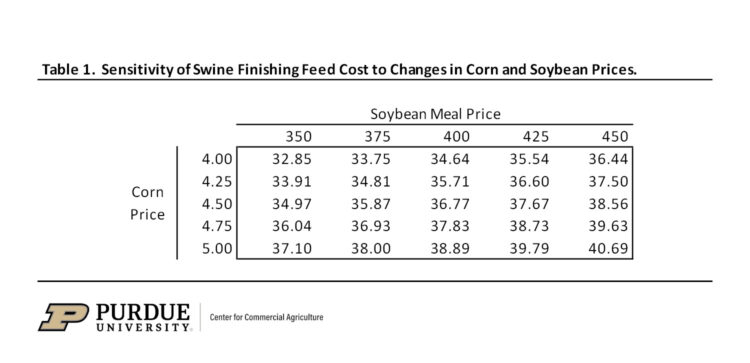November 30, 2023
Prospects for Swine Feed Costs in 2024
by Michael Langemeier
Indiana corn prices during the first three quarters of this year averaged $6.31 per bushel, with a September average of $5.36 per bushel. Since September prices have dropped sharply. The most recent WASDE report indicates that corn prices could remain low for the foreseeable future. Using the iFarm price distribution tool in late November, corn prices for the July 2024 futures contract at the 25th percentile, the 50th percentile, and the 75th percentile were $4.41, $4.89, and $5.42, respectively. The $4.41 price ($5.42 price) indicates that there is a 25 percent chance that the corn price will be below $4.41 (above $5.42) per bushel at the expiration of the July contract. Obviously, lower expected corn prices will translate into lower expected feed costs during the first part of next year. This article examines trends in feed costs as well as the impact of corn and soybean meal prices on feed costs for farrow-to-finish and swine finishing operations.
It is important to note that the swine finishing enterprise represented in this article assumes the finishing of an early-weaned pig. The rations for the farrow-to-finish and swine finishing enterprises consist of corn, soybean meal, dry distillers’ grain, and supplements. Corn prices represent averages for Indiana as reported by USDA-NASS. Soybean meal and distillers’ grain prices are obtained from Feed Outlook, published monthly by USDA-ERS. Information from Agricultural Prices, a monthly USDA-NASS publication, was used to compute supplement prices. Late November futures prices for corn and soybean meal were used to project feed indices for 2024. Feed cost indices are reported on a closeout month rather than a placement month basis.
Corn and Soybean Meal Prices
Figures 1 and 2 report monthly corn and soybean meal prices from January 2007 to September 2023. Corn price averaged $4.75 per bushel from 2007 to the current month. Soybean meal price averaged $363 per ton from 2007 to the current month. Current corn price is below the long-run average, but current soybean meal prices are above the long-run average. Futures prices suggest that corn prices are likely to remain below their long-run average well into next year. Soybean meal prices, on the other hand, are likely to remain above their long-run average. The impact of these corn and soybean meal projections on feed costs are discussed below.
Farrow-to-Finish Enterprise
Figure 3 presents monthly farrow-to-finish feed cost indices from January 2007 to September 2023. The latest full year of indices, 2022, has an index of 100 so all indices outside of that year are expressed in relative terms. The average feed cost index since 2007 is 75.6. The feed cost indices for the first, second, and third quarters of 2023 were 106.3, 104.9, and 102.6, respectively. The feed cost index is projected to decline from 102.6 in the third quarter to approximately 94 in the fourth quarter. Early projections for the first two quarters of 2024, suggest that the feed cost index could range from 79 to 86 during the first six months of next year.
Annual farrow-to-finish feed cost indices are presented in figure 4. The projection for 2024 used corn and soybean meal futures prices in late November. After averaging approximately 102 in 2023, the projected feed cost index for 2024 is 81, which indicates that feed costs in 2024 are expected to be 21 percent lower than they were in 2023.
Swine Finishing Enterprise
Figure 5 illustrates monthly swine finishing feed cost indices for the January 2007 to September 2023 period. The latest full year of indices, 2022, has an index of 100 so all indices outside of this year are expressed in relative terms. The average index for the period beginning in 2007 is 75.5. The average index for 2023 is projected to be 101. Similar to the feed cost index for farrow-to-finish production, the swine finishing feed cost index for 2024 is expected to be substantially below the 2022 and 2023 indices. Annual swine finishing feed cost indices are presented in figure 6. The projection for 2024 used corn and soybean meal futures prices in late November. The expected index for 2024 is 83, which if realized would be 18 percent below the average feed cost index in 2023.
Feed costs are sensitive to changes in corn and soybean meal prices. Regression analysis was used to examine the relationship between swine finishing feed cost, and corn and soybean meal prices during the January 2007 to December 2022 time period. Results are as follows: each 0.10 per bushel increase in corn prices increases feed cost per cwt. by $0.43, and each $10 per ton increase in soybean meal prices increases feed cost per cwt. by $0.36. Obviously, a $0.50 increase or decrease in corn price would have a large impact on feed cost per cwt.
Current feed cost is approximately $42.75 per cwt. Table 1 presents feed cost per cwt. for a range of likely corn and soybean prices in the first and second quarters of next year. Corn prices range from $4.00 to $5.00 per bushel and soybean meal prices range from $350 to $450 in the table. At the lower range of prices, feed cost per cwt. would be approximately $33. At the higher range of prices, feed cost per cwt. would be approximately $41.
Conclusions
This article discussed recent trends in feed costs for farrow-to-finish and swine finishing enterprises, and provided projections for 2024. Average feed costs in 2023 were similar to those experienced in 2022. However, current projections for 2024 indicate that feed costs could be approximately 20 percent lower in 2024. Current projections use corn prices ranging from $4.25 to $4.75 per bushel, and soybean meal prices ranging from $400 to $450 per ton. Corn and soybean prices will be impacted by weather conditions around the world as well as other supply and demand factors. Given the volatility of feed ingredient prices, this article also examined the impact of changes in corn and soybean meal prices on swine finishing feed cost. Each $0.10 per bushel change in corn price, changes feed cost by $0.43 per cwt. Similarly, each $10 per ton change in soybean meal price, changes feed cost by $0.36 per cwt.
References
2023 iFarm Price Distribution Tool, University of Illinois, accessed on November 28, 2023.
USDA-NASS. Quick Stats, accessed on November 28, 2023.
TAGS:
TEAM LINKS:
RELATED RESOURCES
UPCOMING EVENTS
December 1 & 8, 2025
Join Purdue Extension for a two-part workshop designed to help you gain a clearer understanding of tax planning essentials. The first session on December 1 will focus on the fundamentals of farm taxes, with particular emphasis on strategies that can be used in a low net income year. The second session on December 8 will focus on key tax strategies and will allow plenty of time for questions. Registration cost is only $20.
Read MoreDecember 15, 2025
This program provides in-depth coverage of agricultural and farm tax issues. In addition to covering timely tax issues, we will cover disaster tax issues, depreciation and expensing farm assets, retirement planning for farms, and tax planning in low-income years. This year’s webinar will be co-taught by a team from Ohio State and Purdue Universities.
Read MoreJanuary 27 or 28, 2026
Farm Shield is more than a conference, it’s a commitment to helping agricultural families build resilience and plan for a secure future. Don’t miss this opportunity to protect your legacy!
Read More